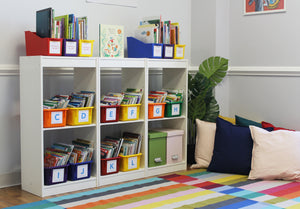The Power of Rereading Read Alouds with Language Learners, Part 2: Literal Comprehension
Last week, I wrote about how to read for lexical comprehension so students can understand new words in the text. Lexical comprehension is the first of three levels of comprehension. The next level is Literal Comprehension, where students learn to answer questions with answers that come straight from the text or illustrations.

Literal Comprehension
With all of the hard work that went into the lexical comprehension read aloud session, it would be a shame to move onto a different book right away. To that end, I’m going to capitalize on all of the groundwork that I laid by intentionally planning vocabulary in ¿Qué estás haciendo? This time, I will aim for literal comprehension. Whereas last week I used RL.K.1 With prompting and support, ask and answer questions about key details in a text and asked just one question repeatedly (¿Qué está leyendo _______?), this time, I want to hone in on RL.K.3 With prompting and support, identify characters, settings, and major events in a story. I know that this standard is a good basis for literal questions because the verb “identify” signals pulling straight from the text or the illustrations. Except, I’m not going to ask lots of questions about characters, setting and major events. Instead, I’m going to concentrate on one of these three skills. I’m going to focus on identifying setting because each two-page spread shows a new setting.
Most literal comprehension questions start with how, what, who, when, where. Every few pages, I’ll ask two literal questions centered around setting.
¿Dónde está Chepito ahora?
¿Cómo lo sabes?
Differentiating for Language Proficiency
I could ask these questions when Chepito is at some of the unusual sites, or I could ask these questions when Chepito is at more familiar locations. Students who are native speakers of Spanish would benefit from learning words such as sitio arqueológico, taller de coches, plaza del pueblo. Kindergarteners who are Spanish language learners will benefit from being introduced to words such as en casa, en el salón de clase, al parque, a la escuela. Depending on who my listeners are, I could focus on some locations, and leave others for a different day (maybe a third reading on setting again).
To be able to answer a question such as How do you know? (¿Cómo lo sabes?) I’m also going to want to give students words to describe these places. If I’m focusing on the house, the school, and the park, I’ll want to mention furniture such as the table, the bench, the chairs, the shelves. I can also mention other elements such as the kitchen for the house, and the trees or grass for the park.
Visual Scaffolding
Backward planning guarantees oral language production during read aloud sessions. If you combine backward planning with strong visual support, you can really enhance student participation. Last week’s focus was on lexical comprehension around different readable materials. This week’s focus is on literal comprehension around setting. Here are the two manila folders that I will use as visual scaffolds.
Day 1: Lexical Comprehension

I’ve found that manila folders are a great visual scaffold because they don’t take up a lot of space, they can be stacked one on top of the other, and I can use the crease as a natural separation between the vocabulary and the questions. On the left side of the manila folder, I write the vocabulary words students will need to answer my questions. To challenge my listeners, I put the vocabulary words out of order so that they have to think critically about which words to use when answering me.
Notice how I’m only asking one question the entire time on Day 1. I ask it multiple times for different pages and characters. So, I have anticipated that students will need the answer stem with the different character names to help them answer the questions completely.
Day 2: Literal Comprehension

On Day 2, I focus on setting. All of my questions are about setting. On the right, I write the questions in one color, and the answers in another color. You’ll notice that there are two answer stems for each question. The first time, it’s because there’s a need for different prepositions based on the location. In the second question, it’s because I want to show students two ways they can justify their answers. Both times, the justifications are going to be based on the illustrations. Therefore, my sentence stems include “veo” and “hay” because these are verbs that we use when we describe what we see.

Above are the first two manila folders I have made to present new vocabulary. There’s a benefit in stacking them: you won’t need to repeat yourself if you’ve presented new words. You can also hold students accountable for using the words that you presented yesterday or the day(s) before. If you know you’re going to use several books on Learning and Growing or Learning New Skills, then presenting these books side by side will help students make connections across books (RL.K.9, RL.1.9).
Next week, I’ll present the third level of comprehension: inferential comprehension. Stay tuned by subscribing to Just Good Teaching here.
Your partner in all things dual language,
marie



Leave a comment